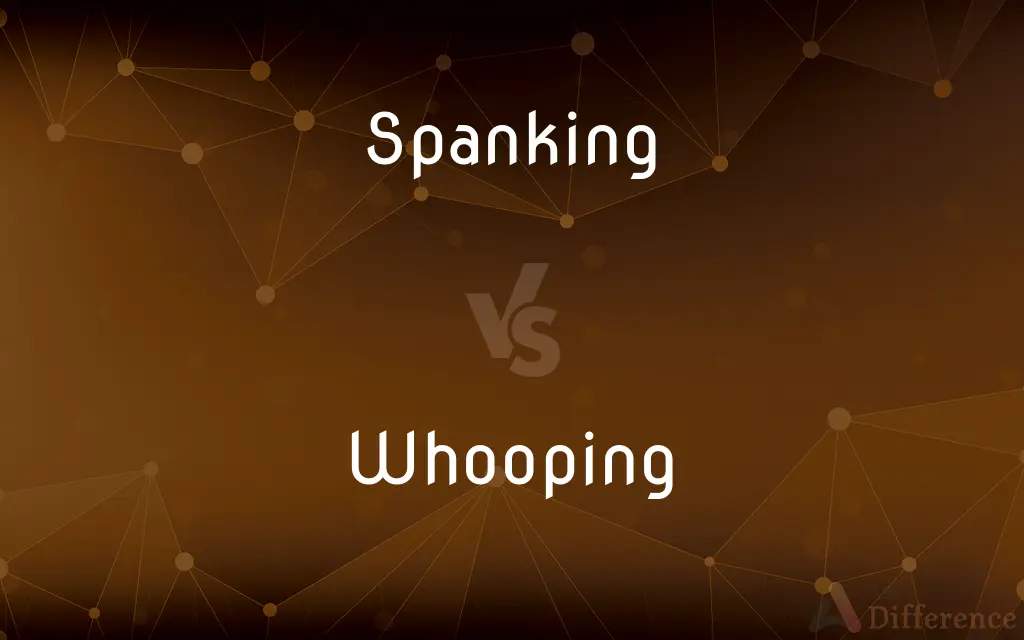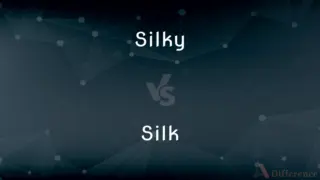Spanking vs. Whooping — What's the Difference?
By Urooj Arif & Fiza Rafique — Updated on April 2, 2024
Spanking involves a light, often open-handed hit to discipline, usually on the buttocks, while whooping is more intense and may use objects, perceived as harsher.

Difference Between Spanking and Whooping
Table of Contents
ADVERTISEMENT
Key Differences
Spanking is generally understood as a disciplinary measure involving a light, open-handed slap primarily on the buttocks or extremities. It is often seen as a traditional form of discipline aimed at correcting behavior in children. On the other hand, whooping refers to a form of punishment that is typically more severe than spanking and may involve the use of belts, switches, or other objects to administer the discipline, suggesting a higher intensity and potential for pain.
The debate around spanking centers on its effectiveness and ethical implications, with proponents arguing it's a necessary tool for teaching right from wrong, and opponents citing research suggesting it may lead to aggression and psychological issues in children. Whooping, due to its intensity, faces sharper criticism. It's often considered abusive by child welfare advocates, who argue that it can lead to more significant emotional and physical harm than spanking, potentially affecting children's long-term well-being.
Cultural and regional attitudes significantly influence the perception and acceptance of spanking and whooping. Spanking, while declining in acceptance in many Western cultures due to evolving views on child discipline, remains a common practice in others. Whooping, however, is generally viewed more negatively across a broader spectrum, with many considering it an outdated and harmful method of discipline that should be avoided.
In terms of legal status, spanking is still permitted as a form of disciplinary action in the home in many countries, with specific guidelines to prevent abuse. Whooping, particularly when it involves objects or results in injury, is more likely to be classified under child abuse in legislation, reflecting a global shift towards protecting children from physical harm.
Educational and parenting experts advocate for alternatives to both spanking and whooping, promoting positive reinforcement, time-outs, and communication as more effective and less harmful methods for disciplining children. These approaches aim to teach children about consequences and correct behavior through understanding and empathy rather than fear or pain.
ADVERTISEMENT
Comparison Chart
Definition
A light, open-handed slap, usually on the buttocks, as a disciplinary measure.
A harsher form of punishment, often involving objects like belts or switches.
Intensity
Generally light and less likely to cause physical harm.
More intense, with a higher risk of physical and emotional harm.
Perception
Mixed, with some viewing it as an acceptable form of discipline.
Generally viewed more negatively, with many considering it abusive.
Legal Status
Legal in many places with restrictions to prevent abuse.
More likely to be considered abusive and illegal, especially when causing injury.
Alternatives
Positive reinforcement, time-outs, communication.
Positive reinforcement, time-outs, communication, emphasizing non-physical methods.
Compare with Definitions
Spanking
A form of punishment involving a slap, usually with an open hand.
After the child lied, the parent resorted to spanking as punishment.
Whooping
A severe form of punishment that may involve objects.
The use of a belt for whooping is common in some households.
Spanking
Aimed at correcting behavior without causing injury.
The spanking was meant to teach a lesson about honesty.
Whooping
Widely criticized and considered abusive.
Child welfare organizations campaign against the practice of whooping.
Spanking
Can be legal with specific limitations.
In some jurisdictions, spanking is allowed if it doesn't leave marks or bruises.
Whooping
Often leads to a higher risk of harm.
The child suffered bruises from the whooping.
Spanking
Viewed differently across cultures.
Spanking is considered a normal disciplinary method in some cultures.
Whooping
Usually illegal when it causes physical injury.
The law intervenes in cases where whooping results in visible harm to the child.
Spanking
Often debated in terms of effectiveness and ethics.
Many parents weigh the pros and cons of spanking in discipline.
Whooping
Encourages the search for non-physical discipline methods.
After learning about the risks of whooping, many seek alternative discipline methods.
Spanking
Spanking is a common form of corporal punishment involving the act of striking, with either the palm of the hand or an implement, the buttocks of a person to cause them physical pain. Although the term spanking broadly encompasses the use of either the hand or implement, the use of implements can also refer to the administration of more specific types of corporal punishment such as caning, paddling and slippering.
Whooping
A loud cry of exultation or excitement.
Spanking
(Informal) Exceptional of its kind; remarkable.
Whooping
A shout uttered by a hunter or warrior.
Spanking
Swift and vigorous
A spanking pace.
Whooping
A hooting cry, as of a bird.
Spanking
Brisk and fresh
A spanking breeze.
Whooping
The paroxysmal gasp characteristic of whooping cough.
Spanking
Used as an intensive
A spanking clean shirt.
Whooping
To utter a loud shout or cry.
Spanking
A number of slaps on the buttocks delivered in rapid succession, as for punishment.
Whooping
To utter a hooting cry.
Spanking
Present participle of spank
Whooping
To make the paroxysmal gasp characteristic of whooping cough.
Spanking
Fast and energetic.
A spanking pace
Whooping
To utter with a whoop.
Spanking
Brisk and fresh.
A spanking breeze
Whooping
To chase, call, urge on, or drive with a whoop
Whooping the cattle down the road.
Spanking
An intensifier.
Brand spanking new
A spanking good time
Spanking clean
Spanking white
Whooping
Present participle of whoop
Spanking
A form of physical punishment in which a beating is applied to the buttocks.
Domestic spanking is often endured over the knee (or lap), formal spanking rather applied over a contraption such as a tresle or A-frame, with or without constraints
Whooping
Alternative form of whupping
Spanking
An incident of such punishment, or such physical act in a non-punitive context, such as a birthday spanking.
Spanking
Moving with a quick, lively pace, or capable of so doing; dashing.
Four spanking grays ready harnessed.
Spanking
Large; considerable.
Spanking
Very; extremely; - used especially in the phrase spanking new or brand spanking new, meaning completely new and unused.
Spanking
The act of slapping on the buttocks;
He gave the brat a good spanking
Spanking
Quick and energetic;
A brisk walk in the park
A lively gait
A merry chase
Traveling at a rattling rate
A snappy pace
A spanking breeze
Common Curiosities
Can spanking lead to psychological issues in children?
Studies suggest that spanking can be associated with aggression and psychological issues in children.
Why is whooping viewed more negatively than spanking?
Whooping is considered more severe and has a higher risk of causing physical and emotional harm, leading to broader criticism.
What is the main difference between spanking and whooping?
Spanking is a lighter form of discipline involving an open hand, while whooping is harsher and may involve objects.
How do cultural attitudes affect the practice of spanking and whooping?
Cultural and regional attitudes significantly influence the acceptance and practice of both, with spanking being more accepted in some cultures than whooping.
How is the effectiveness of spanking and whooping measured?
Effectiveness is often debated, with studies focusing on behavioral outcomes, emotional health, and long-term effects on children.
What are the alternatives to spanking and whooping?
Alternatives include positive reinforcement, time-outs, and communication, which focus on teaching through understanding rather than fear.
Is spanking considered legal?
Spanking is legal in many places, with restrictions to prevent abuse, whereas whooping, especially if it causes injury, is more likely to be considered illegal.
What legal protections exist against whooping?
Many jurisdictions have laws protecting children from abuse, classifying severe forms of whooping as illegal.
What are the long-term effects of whooping on children?
Long-term effects can include increased aggression, antisocial behavior, and psychological issues.
How can parents discipline without spanking or whooping?
Parents can use methods like positive reinforcement, setting clear expectations, and using natural consequences.
Are there any benefits to spanking or whooping?
While some argue these methods can lead to immediate compliance, most experts advocate for non-physical discipline due to potential negative effects.
Can spanking ever be considered non-abusive?
Legally, spanking can be considered non-abusive if it doesn't cause injury or distress, though opinions on this vary.
What role do schools play in disciplining children?
Schools typically enforce discipline through policies that do not involve physical punishment, focusing on behavioral correction and education.
How do parenting styles influence the use of spanking and whooping?
Parenting styles greatly influence disciplinary methods, with more authoritarian styles likely to use spanking or whooping, while more permissive or authoritative styles may opt for non-physical methods.
Why do some parents choose spanking over other disciplinary methods?
Some parents may view spanking as a quick and effective way to correct behavior, influenced by cultural norms or personal upbringing.
Share Your Discovery

Previous Comparison
Augury vs. Prophecy
Next Comparison
Silky vs. SilkAuthor Spotlight
Written by
Urooj ArifUrooj is a skilled content writer at Ask Difference, known for her exceptional ability to simplify complex topics into engaging and informative content. With a passion for research and a flair for clear, concise writing, she consistently delivers articles that resonate with our diverse audience.
Co-written by
Fiza RafiqueFiza Rafique is a skilled content writer at AskDifference.com, where she meticulously refines and enhances written pieces. Drawing from her vast editorial expertise, Fiza ensures clarity, accuracy, and precision in every article. Passionate about language, she continually seeks to elevate the quality of content for readers worldwide.
















































